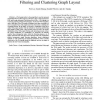SIGIR
2011
ACM
13 years 9 months ago
2011
ACM
Test collections are the primary drivers of progress in information retrieval. They provide a yardstick for assessing the effectiveness of ranking functions in an automatic, rapi...
IFIP12
2009
14 years 4 months ago
2009
In this paper we propose a web search methodology based on the Ant Colony Optimization (ACO) algorithm, which aims to enhance the amount of the relevant information in respect to a...
ICIW
2009
IEEE
14 years 4 months ago
2009
IEEE
Web spamming, the practice of introducing artificial text and links into web pages to affect the results of searches, has been recognized as a major problem for search engines. Bu...
SOCIALCOM
2010
14 years 4 months ago
2010
A representation of the World Wide Web as a directed graph, with vertices representing web pages and edges representing hypertext links, underpins the algorithms used by web search...
ML
2010
ACM
14 years 5 months ago
2010
ACM
We present an algorithm, witch, that learns to detect spam hosts or pages on the Web. Unlike most other approaches, it simultaneously exploits the structure of the Web graph as wel...
CN
2002
14 years 6 months ago
2002
Recently several authors have proposed stochastic models of the growth of the Web graph that give rise to power-law distributions. These models are based on the notion of preferen...
CIB
2005
14 years 6 months ago
2005
A Web graph refers to the graph that is used to represent relationships between Web pages in cyberspace, where a node represents a URL and an edge indicates a link between two URLs...
IJMMS
2007
14 years 6 months ago
2007
What does a ‘normal’ computer (or social) network look like? How can we spot ‘abnormal’ sub-networks in the Internet, or web graph? The answer to such questions is vital f...
IM
2006
14 years 6 months ago
2006
Recent work on modeling the web graph has dwelt on capturing the degree distributions observed on the web. Pointing out that this represents a heavy reliance on "local" p...
DM
2008
14 years 6 months ago
2008
Abstract. The web graph is a real-world self-organizing network whose vertices correspond to web pages, and whose edges correspond to links between pages. Many stochastic models fo...





